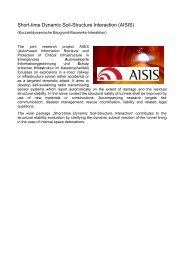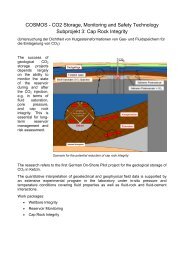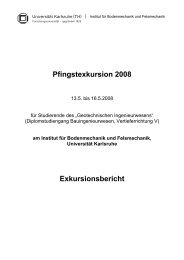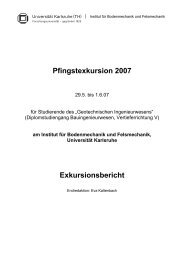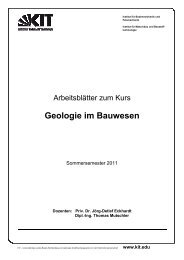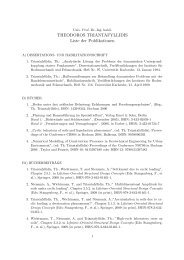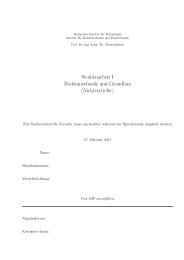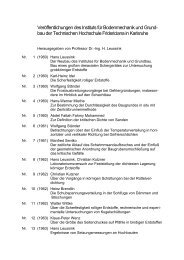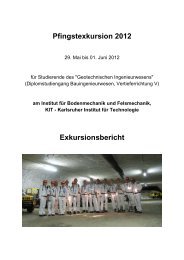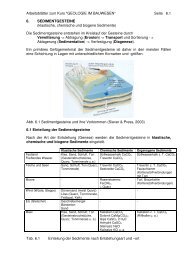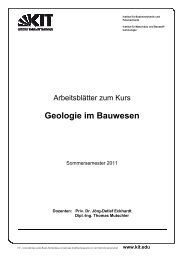PSAMMODYNAMICS: ATTRACTORS AND ENERGETICS
PSAMMODYNAMICS: ATTRACTORS AND ENERGETICS
PSAMMODYNAMICS: ATTRACTORS AND ENERGETICS
Create successful ePaper yourself
Turn your PDF publications into a flip-book with our unique Google optimized e-Paper software.
forthcoming paper ’Seismo- and thermodynamics of granular solids’ (Gudehus et al. 2010, STG in the sequel)<br />
this theory was supported by further arguments, modified and quantified. Instead of GSH it may be called<br />
psammodynamics as psammoids are matter in its own right. This concept is shown in Sec. 2 to reproduce<br />
hypoplastic relations within bounds given by the two attractors mentioned above.<br />
Attractors for non-monotonous evolutions of cylindrical samples are introduced in Sec. 3. As long as<br />
localization and decay are avoided combinations of isochoric monotonous and cyclic deformations lead to stress<br />
cycles, these attractors serve to judge and quantify elastoplastic and hypoplastic relations with hidden variables<br />
(PSM). A unified representation enables an evolution equation relating average changes of shape and state.<br />
This rate-independent equation is supported by STG, but more experiments and simulations will be needed for<br />
a detailed validation and calibration.<br />
Systems with sand and attached solids are considered in Sec. 4. Model towers serve to introduce the total<br />
free energy which is needed to judge stability, stabilization and destabilization. Other than with an elastic<br />
ground sand gets rearranged by pulsating seismicity, with it the system can have an attractor or a repeller. The<br />
novel constitutive model is thought to predict gradual changes of position and state, whereas an impending<br />
collapse can as yet at best be estimated. Pore water and elastic structures can be incorporated, this concept<br />
works for a wide range of initial and boundary conditions. After a conclusion it is indicated in Sec. 4 how it<br />
could be applied for solids and with thermal activation.<br />
2 MONOTONOUS DEFORMATIONS OF SAMPLES<br />
Some evolutions of cylindrical sand samples (like in perfect so-called triaxial tests, PSM) are shown in Fig.<br />
1. The imposed strain paths (a, axial ε 1 , radial ε 2ε 3 ) may be proportional with contraction (A), constant<br />
volume (B) or dilation (C). The obtained stress path (b) tends to a straight line from the origin (A), a point (B)<br />
or a straight line towards the origin (C), respectively. This behavior is also visible from response polars which<br />
represent stress rates for unit strain rates with different directions. As plotted they resemble ellipses which are<br />
bigger for higher pressures and more eccentric for bigger ratios of shear and normal stress. A plot of void ratio<br />
e versus mean pressure pÔσ 1 2σ 3Õß3 exhibits an approach to limit curves (c) with p-increase (A), stationary<br />
p (B) or p-decrease (C).<br />
c<br />
C<br />
ε 1 A<br />
i<br />
√2ε 2<br />
B<br />
-c<br />
a)<br />
σ s1 c A<br />
i<br />
B<br />
C<br />
-c<br />
√2 σ s2<br />
e<br />
i<br />
c<br />
d<br />
B<br />
C<br />
A<br />
b)<br />
c)<br />
log(p s<br />
/h s<br />
)<br />
Figure 1: a) Proportional deformations of a cylindrical psammoid sample, b) induced stress paths with<br />
response polars, c) induced evolutions of void ratio versus pressure<br />
Theseevolutions,andsimilaroneswithmonotonousstrainpaths,arecharacterizedbytwokindsofattractors.<br />
Firstthehiddeninternalstateisalignedbythedeformationtothestressstatesothatitisnotneededexplicitlyin<br />
constitutive relations. Thereafter the sample approaches a state limit with a loss of uniformity, viz. compaction<br />
bands (A), shear bands (B) or decay (C). Elastoplastic relations with density hardening capture contractant<br />
and isochoric paths except for very low or high pressures, very dilatant paths with low relative void ratios are<br />
missed. Hypoplastic relations imply more realistic response polars (Kolymbas and Wu 1993) and work for a<br />
wider range of void ratios and pressures. Both models ignore the spontaneous loss of uniformity near state<br />
limits. Shear localizations can be captured by means of additional polar quantities, they arise spontaneously<br />
with bifurcation (Vardoulakis and Georgopoulos 2005 ) and can tend to fractal patterns (PSM).<br />
The grains are jammed so that they have a specific elastic energy w e which is a function of the averageelastic<br />
strain components u i and the density ρ or void ratio e. The elastic stress π i is conjugated with u i via w e by<br />
π i¡w eßu i . Due to increasing contact flats w e should depend on ∆¡Σu i by w e∆m with an exponent



